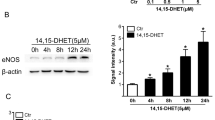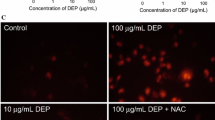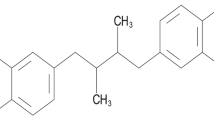Abstract
Diesel exhaust particles contain redox-active quinones, such as 9,10-phenanthraquinone (9,10-PQ) and 1,2-naphthoquinone (1,2-NQ), which act as potent electron acceptors, thereby altering electron transfer on proteins. We have previously found that 9,10-PQ inhibits constitutive nitric oxide synthase (NOS) activity, by shunting electrons away from NADPH on the cytochrome P450 reductase domain of NOS, and thus suppresses acetylcholine (Ach)-induced vasorelaxation in the aortic ring. However, the effect of 1,2-NQ on endothelial NOS (eNOS) activity is still poorly understood. With the membrane fraction of cultured bovine aortic endothelial cells, we found that 1,2-NQ was a potent inhibitor of eNOS with an IC50 value of 1.4 μM, whereas trans-1,2-dihydroxy-1,2-dihydronaphthalene (1,2-DDN), a redox-negative naphthalene analog of 1,2-NQ, did not show such an inhibitory action. Although 1,2-DDN (5 μM) did not affect Ach-mediated vasorelaxation, 1,2-NQ caused a significant suppression of Ach-induced endothelium-dependent vasorelaxation in the aortic ring. However, 1,2-NQ did not affect sodium nitroprusside-induced endothelium-independent vasorelaxation. These results suggest that 1,2-NQ is an environmental quinone that inhibits eNOS activity, thereby disrupting NO-dependent vascular tone.





Similar content being viewed by others
Abbreviations
- 1,2-NQ:
-
1,2-Naphthoquinone
- 1,2-DDN:
-
trans-1,2-Dihydroxy-1,2-dihydronaphthalene
- NO:
-
Nitric oxide
- eNOS:
-
Endothelial nitric oxide synthase
- Ach:
-
Acetylcholine
- SNP:
-
Sodium nitroprusside
References
Calver A, Collier J, Moncada S, Vallance P (1992) Effect of local intraarterial NG-monomethyl-l-arginine in patients with hypertension: the nitric oxide dilator mechanism appears abnormal. J Hypertens 10:1025–1031
Cho AK, Stefano ED, You Y, Rodriguez CE, Schmitz DA, Kumagai Y, Miguel AH, Eiguren-Fernandez A, Kobayashi T, Avol E, Froines JR (2004) Determination of four quinones in diesel exhaust particles, SRM 1649a and atmospheric PM2.5. Aerosol Sci Technol 38:1–14
Dockery DW, Pope AC III, Xu X, Spengler JD, Ware JH, Fay ME, Ferris BG Jr, Speizer FE (1993) An association between air pollution and mortality in six US cities. N Engl J Med 329:1753–1759
Furchgott RF, Zawadzki J (1980) The obligatory role of endothelial cells in the relaxation of arterial smooth muscle by acetylcholine. Nature 89:288–373
Gopalakrishna R, Anderson WB (1982) Ca2+-induced hydrophobic site on calmodulin: application for purification of calmodulin by phenyl-sepharose affinity chromatography. Biochem Biophys Res Commun 104:830–836
Hiura TS, Kaszubowski MP, Li N, Nel AE (1999) Chemicals in diesel exhaust particles generate reactive oxygen radicals and induce apoptosis in macrophages. J Immunol 163:5582–5591
Ignarro LJ (1989) Endothelium-derived nitric oxide: actions and properties. FASEB J 3:31–36
Ikeda M, Suzuki M, Watarai K, Sagai M, Tomita T (1995) Impairment of endothelium-dependent relaxation by diesel exhaust particles in rat thoracic aorta. Jpn J Pharmacol 68:183–189
Kumagai Y, Nakajima H, Midorikawa K, Homma-Tkakeda S, Shimojo N (1998) Inhibition of nitric oxide formation by neuronal nitric oxide synthase by quinines: nitric oxide synthase as a quinine reductase. Chem Res Toxicol 11:608–613
Kumagai Y, Hayashi T, Miyauchi T, Endo A, Iguchi A, Sakai MK, Sakai S, Yuki K, Kikushima M, Shimojo N (2001) Phenanthraquinone inhibits eNOS activity and suppresses vasorelaxation. Am J Physiol Regul Integr Comp Physiol 281:R25–R30
Kumagai Y, Koide S, Taguchi K, Endo A, Nakai Y, Yoshikawa T, Shimojo N (2002) Oxidation of proximal protein sulfhydryls by phenanthraquinone, a component of diesel exhaust particles. Chem Res Toxicol 15:483–489
Li N, Venkatesan MI, Miguel A, Kaplan R, Gujuluva C, Alam J, Nel AE (2000) Induction of heme oxygenase-1 expression in macrophages by diesel exhaust particle chemicals and quinines via the antioxidant-responsive element. J Immunol 165:3393–3401
Moncada S, Higgs A (1993) The l-arginine-nitric oxide pathway. N Engl J Med 329:2002–2012
Moncada S, Palmer RMJ, Higgs EA (1991) Nitric oxide: physiology, pathophysiology, and pharmacology. Pharmacol Rev 43:109–142
Palmer RMJ, Ferrige AG, Moncada S (1987) Release of nitric oxide accounts for the biological activity of endothelium-derived relaxing factor. Nature 327:524–526
Platt KL, Oesch F (1983) Efficient synthesis of non-K-region trans-dihydro diols of polycyclic aromatic hydrocarbons from o-quinone and catachol. J Org Chem 48:265–268
Pope CA III, Thun MJ, Namboodiri MM, Dockery DW, Evans JS, Speizer FE, Heath CW Jr (1995) Particulate air pollution as a predictor of mortality in a prospective study of US adults. Am J Respir Crit Care Med 151:669–674
Radomski MW, Palmer RM, Moncada S (1987) The anti-aggregating prostacyclin and nitric oxide. Br J Pharmacol 92:639–646
Sagai M, Saito H, Ichinose T, Kodama M, Mori Y (1993) Biological effects of diesel exhaust particles I In vitro production of superoxide and in vivo toxicity. Free Radic Biol Med 14:37–47
Stewart AG, Phan LH, Grigoriadis G (1994) Physiological and pathophysiological roles of nitric oxide. Microsurgery 15:693–699
Sugimoto R, Kumagai Y, Nakai Y, Ishii T (2005) 9,10-Phenanthraquinone in diesel exhaust particles downregulates Cu, Zn-SOD and HO-1 in human pulmonary epithelial cells: intracellular iron scavenger 1,10-phenanthroline affords protection against apoptosis. Free Radic Biol Med 38:388–395
Sun Y, Iemitsu M, Shimojo N, Miyauchi T, Amamiya M, Sumi D, Hayashi T, Sun GF, Shimojo N, Kumagai Y (2005) 2,4,6-Trinitrotoluene inhibits endothelial nitric oxide synthase activity and elevates blood pressure in rats. Arch Toxicol (in press)
Acknowledgments
We are especially grateful to Ms. F. Miyamasu for grammatical corrections in the preparation of this manuscript. This research was supported in part by Grant-in-Aid #15390184 and #15659141 (YK) for scientific research from the Ministry of Education, Science, Culture and Sports of Japan.
Author information
Authors and Affiliations
Corresponding author
Additional information
An erratum to this article can be found at http://dx.doi.org/10.1007/s00204-006-0127-8
Rights and permissions
About this article
Cite this article
Sun, Y., Taguchi, K., Sumi, D. et al. Inhibition of endothelial nitric oxide synthase activity and suppression of endothelium-dependent vasorelaxation by 1,2-naphthoquinone, a component of diesel exhaust particles. Arch Toxicol 80, 280–285 (2006). https://doi.org/10.1007/s00204-005-0043-3
Received:
Accepted:
Published:
Issue Date:
DOI: https://doi.org/10.1007/s00204-005-0043-3




